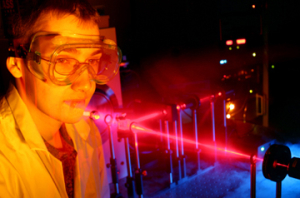Imagine storing the entire Library of Congress on a Palm Pilot, or storing 1,000 movies on a 2-inch disk.
These are the kinds of the futuristic goals that could become feasible if UH engineers are successful in their bid to create the first nano-patterned medium recording (N-PMR) at the scale of one terabyte per square inch and explore the physical limits of magnetic data storage in units only four nanometers in size.
Dmitri Litvinov, associate professor of electrical engineering, is the principal investigator of a new research project that recently received funding of $1.1 million from the National Science Foundation. The project could enable the multibillion-dollar magnetic data storage industry to continue its record-setting growth rate for the next 10 to 15 years, says Litvinov, who is working closely with co-principal investigator Jack Wolfe, professor of electrical engineering.
Wolfe’s recent innovations in atom beam lithography will provide much of the nano-scale precision needed for the project. His new technology, dubbed “massively parallel direct-write atom beam lithography,” delivers highly reliable, inexpensive sub-10 nm resolution. The theoretical limit of this new technology ranges between 1 and 2 nm, only one order of magnitude above the atomic level.
“If we can make this work, this could be something really big for the data storage industry,” Litvinov says. “The data density of magnetic hard drives has doubled every year for the past five years. But that impressive growth rate is now threatened because they’re running out of options. They’re running into some fundamental limits. Our system will allow them to extend this limit by a factor of 10. Maybe more.”
The fundamental limit that Litvinov refers to is called the superparamagnetic limit, a predicament that will bring the industry’s impressive growth rate to halt by as soon as 2007, Litvinov says. This limit has to do with the relationship between the density of each crystallite and the magnetic and thermal energy necessary to read and write onto the medium. Currently, there are only two options for meeting the challenge of the superparamagentic limit, thermally assisted recording, which would be extremely complicated and expensive, and N-PMR, which is the technique Litvinov and his colleagues are developing.
“The big difference between current practices and what we are proposing is we want to record on a single crystallite,” Litvinov says. “Right now, we record on 50 to 100 crystallites because you need that many to have a high signal-to-noise ratio. You suppress noise by averaging many of them. Now if we could design things so that each crystallite is located in a specific place—in a lithographically defined place—then we can record on individual crystallites.”
As the project moves forward over the next four years, the engineers plan to extend the technology to the 4 nm limit using self-assembled nanoparticle masks confined by lithographically defined tracks and then test the N-PMR “islands” using a read-write head on a scanning probe. Next, they will fabricate flyable disks for spin-scan testing of signal-to-noise ratio, bit error rates, and thermal stability. Corporate partners with testing and other aspects of the project include Seagate Technologies; Molecular Imprints, Inc.; LBNL and Euxine Technologies LLC.
One key to the success of the project will be the work of UH collaborator T. Randall Lee, professor of chemistry and chemical engineering, who will lead the effort to create masks using self-assembling nanoparticles.
“Our job is to make nanoparticles in such a way that they all have the same size and shape,” says Lee. “We are going to focus on ways to do that extremely well, at the forefront of technology, because to do the sort of patterning we want, we need to have particles that have uniform size and shape. If we can make these particles, then we’re going to use them as part of the templating process for growing patterns. For example, we will take the particles and coat them with an organic film, an organic monolayer that has a certain composition, and that composition will dictate how the nanoparticles arrange themselves in a two-dimensional grid.”
When the nanoparticles arrange themselves the way Lee wants them to, they will form a mask for use in lithography. He uses self-assembly to coat the gold nanoparticles with the appropriate functional groups, and then uses those functional groups to assemble the particles into an array that will form a specific pattern, a patterned mask. Lee and his associates hope to reach down to the 10 nm scale.
“The trick is getting the nanoparticles prepared in a fashion where they’re all the same size and shape and then getting them coated with the appropriate material so that you can get them to assemble in a regular pattern,” he says. “What we bring to the table is expertise in nanoparticle synthesis and coatings technology. Our group has for 10 years now been working in self-assembled thin films. We know how to make these coatings so that we can tailor the properties very specifically. The challenge is to avoid defects.”
Litvinov’s co-principal investigators include Wolfe; Lee; Dieter Weller, executive director of media research at Seagate Technologies; and C. Grant Willson, engineering professor at the University of Texas at Austin and co-inventor of the step-and flash imprint lithography.
